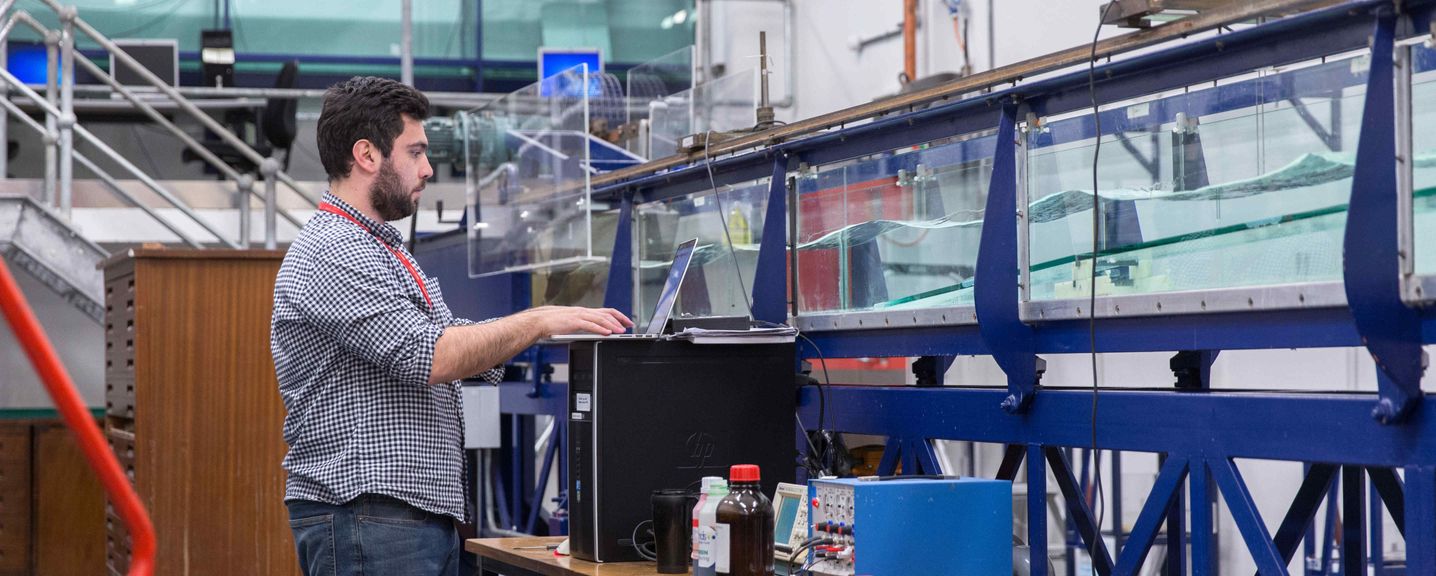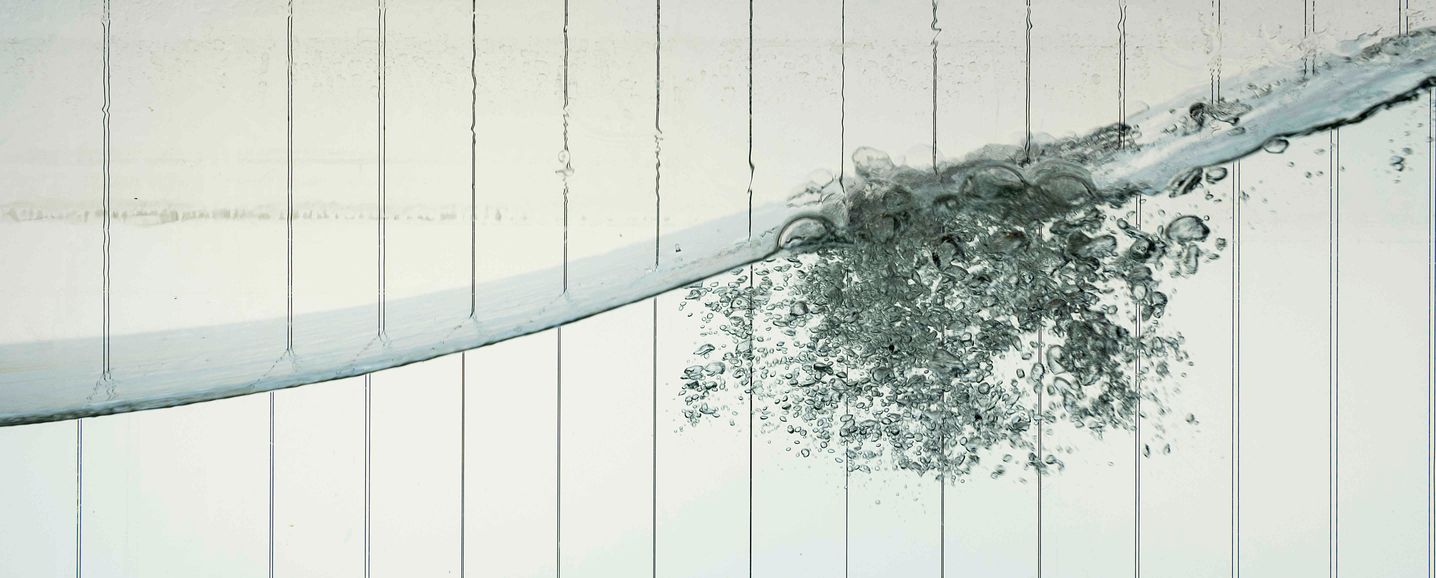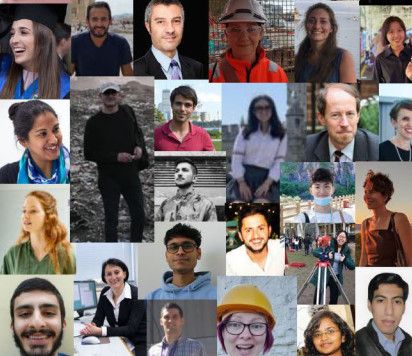Scholarship and funding opportunities
Find out more about the funding available for 2023/24
The offshore, coastal and built environments represent a unique combination of areas, providing students with a well-rounded and broad knowledge of civil engineering fluid mechanics. Students will have access to the world-class Hydrodynamics Laboratory at Imperial College London to perform and observe experimental investigations. This will allow students to cement principles taught during lectures, as well as inspiring the future crop of Engineers in Fluid Mechanics. In addition, there is a strong design component to the programme in the shape of four projects to emphasise application and industry relevance. Furthermore, students will also have the opportunity to undertake research with academics within the top-rated Civil and Environmental Engineering Department from recent research assessment exercises. This MSc programme was established in 2017.
Take a look at some of our recent activity on our Facebook page or Twitter feed.
Intro about course and reasons
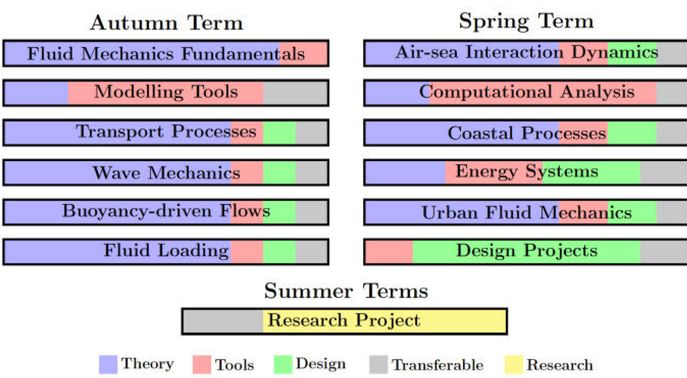
What is the programme layout?
This programme of study is made up of:
- 11 taught modules,
- 1 module comprising 2 design projects and
- 1 research project.
The flow chart above outlines the programme layout and highlights the key skills you will learn in each of the individual modules. You will notice that each module offers a variety of skills and the programme is structured to help you excel whatever your background;
- the first term is more theoretical and tool based,
- the second term increasingly design orientated and
- the final term is dedicated to research so that you can really apply the knowledge you’ve gained.
Transferable skills will focus on technical writing, oral presentations and team working. We have designed these modules to be complementary and teach a wide range of the skills required by modern engineers, whilst providing you with lots of exposure to design and research.
Find out more about each of the modules further down this page.
Who is the programme aimed at?
Anyone who is able and enjoys engineering and fluid mechanics. All students with a solid first degree in Science, Maths or Engineering-based subjects and an interest in Fluid Mechanics. Engineers with significant work experience who would like to specialise in Fluid Mechanics are also encouraged to apply. Hear from some of our former students below.
Why should I study this programme?
The programme material covers cutting-edge techniques, develops key skills and prepares you ideally for the future.
The programme will teach you a wide range of key skills that you can then apply across all Fluid Mechanics disciplines. The programme will cover theoretical concepts, problem solving tools, numerical methods, experimental techniques and design principles. These skills will be presented with an emphasis on Civil Engineering applications in the Offshore, Coastal and Built Environments. However, the skills you will acquire have much broader application, to pretty much any branch of Fluid Mechanics relevant to engineering - this gives you all the flexibility you’ll need in your future career path.
The University is one of the best in the world.
Imperial College London is consistently ranked in the top 10 universities in the World and top 5 in Europe. The Department of Civil & Environmental Engineering itself is considered one of the best in the World and consistently excels in both teaching and research (See 2019 National Student Survey and our top ranking in recent research assessments. See more reasons to choose Imperial.
The City is one of the most vibrant and exciting places to live, let alone be a student.
London is a vibrant, global, capital that is ranked amongst the best student cities in the world. Everything from global Engineering consultancies to niche start-ups are located on your doorstep, offering you a wide range of opportunities for networking and applying for jobs.
Continue reading for module information and frequently asked questions (FAQs).
Convinced already? Apply now.
Meet some of our recent students
Ahmad Uppal
/prod01/channel_3/media/migration/faculty-of-engineering/Uppal,-Ahmad_PGT_Rep_2018--tojpeg_1582733237873_x4.jpg)
Ahmad Uppal
2017/18 MSc graduate
Joanne Steiner
/prod01/channel_3/media/migration/faculty-of-engineering/steiner-joanne-pgt-flu-2020_1595238861061_x4.jpg)
Joanne Steiner
2019/20 MSc candidate
Maria Rodriguez Peralta
/prod01/channel_3/media/migration/faculty-of-engineering/Peralta-Maria_PGT_Flu_2020--tojpeg_1582732959509_x4.jpg)
Maria Rodriguez Peralta
2017/18 MSc graduate
Matthew Tse
/prod01/channel_3/media/migration/faculty-of-engineering/Tse-Matthew_PGT_Flu_2020--tojpeg_1582218783214_x4.jpg)
Matthew Tse
2018/19 MSc graduate
Noel Howell
/prod01/channel_3/media/migration/faculty-of-engineering/howell-noel-pgt-flu-2020_1595239762563_x4.jpg)
Noel Howell
2019/20 MSc Candidate
Vinay Nelli
/prod01/channel_3/media/migration/faculty-of-engineering/nelli-vinay-pgt-flu-2020_1597181857924_x4.jpg)
Vinay Nelli
2019/20 MSc Candidate
Yichong Chen
/prod01/channel_3/media/migration/faculty-of-engineering/chen-yichong-pgt-flu-2020_1597178131881_x4.jpg)
Yichong Chen
2019/20 MSc Candidate
Yufei Wang
/prod01/channel_3/media/migration/faculty-of-engineering/Wang-Yufei_PGT_Flu_2020--tojpeg_1582733050450_x4.jpg)
Yufei Wang
2017/18 MSc graduate
Find out more about the background and motivations of some of our previous students. 2017/18, 2018/19, 2019/20.
Indicative Programme Syllabus
Lectures will form a significant component of the teaching approach. They will be delivered by a mix of academics and external speakers from industry with relevant expertise. Tutorials will enable the students to test their understanding of the lecture material, ask specific questions and consolidate their knowledge. There will be a good balance of theory and practice throughout the programme. This is achieved with laboratory investigations and demonstrations as well as during the design projects. Finally, the research project will enable students to learn skills essential for independent research. The project may be undertaken at College or in collaboration with industry. The module content provided is indicative and is subject to annual update.
To complete the MSc, all students registered for the MSc in Engineering Fluid Mechanics for the Offshore, Coastal and Built Environments must undertake all modules.
Pre-session (Non-assessed)
- CI9-FM-00A: Mathematics Primer
- CI9-FM-00B: Matlab Primer
Autumn Term modules
CIVE70073 Fluid Mechanics Fundamentals
In order to build towards realistic Fluid Mechanics applications, it’s necessary to consolidate the fundamentals of the subject. This module will create a solid foundation in Fluid Mechanics upon which the subsequent modules will build.
You will learn about the fundamental physics of fluid flows and appreciate a wide range of fluid properties and behaviours. This will include general conservation laws, steady and unsteady flow as well as Eulerian and Lagrangian descriptions. We will then go over the Euler and Navier-Stokes equations, laminar and turbulent flows, scaling and similarity, and finish by introducing turbulence.
Read the full module descriptor.

CIVE70074 Modelling Tools
Fluid flows are complex (they would be no fun if they were too easy!) but they are everywhere – right from living-and-breathing itself to the environment we experience around us. This module brings together fundamental fluid mechanics with mathematical modeling tools and deploys them to solve genuine physical phenomena of real application.
Core to the module is the distillation of complex physical situations to simplified governing physics and clear communication in both written and oral presentation. The learning that you’ll do in this module will complement and underpin your approaches to solving any fluid flows you’ll meet in this course and in any engineering application – moreover, it will change the way you approach problem solving far beyond fluid mechanics.
Read the full module descriptor.
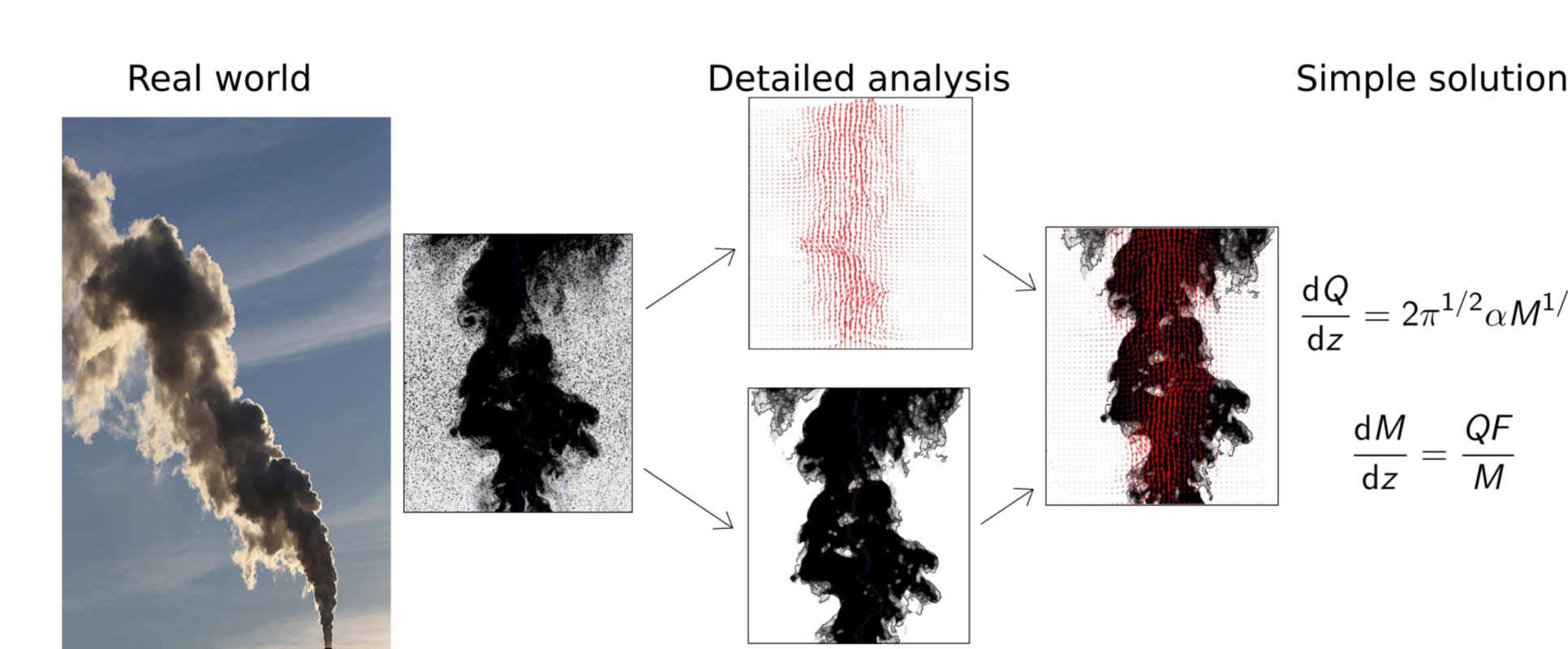
CIVE70075 Transport Processes
The dispersion of pollutants within the atmosphere, rivers, lakes or oceans is of key consideration for controlling the release of contaminants and preventing environmental disasters. Furthermore, the transport of sediments is essential in understanding erosion and accretion in rivers and coastal areas, both of which play a key role in managing the risk of flooding.
This module will highlight the significance of transport processes in the areas of pollutant dispersion and sediment transport. In this module you will appreciate the physical processes that govern the transport of fluids, tracers and sediments. You will also formulate mathematical models that can describe these physical processes. In addition, you will understand the influence of turbulence and dispersion on scalar transport and how these can be modelled.
Read the full module descriptor.
![[Top left] View of the uranium mill tailings pile in Moab, Utah, [Top-right] Sediment transport within Toklat river, Alaska, USA,[ Bottom-left] Coastal sediment transport at Assateague Island, Maryland, USA, [Bottom-right] Air pollution from fossil-fuel power station](/media/migration/faculty-of-engineering/CI9-FM-03_Transport_processes--tojpeg_1481557894323_x2.jpg)
CIVE70076 Wave Mechanics
In the offshore and coastal environments, ocean waves generate the largest forces on man-made and natural structures. This is due to the high density of water as well as the large velocities and accelerations generated by ocean waves. Consequently, a comprehensive understanding of wave mechanics is an essential skill for any Offshore or Coastal Engineer.
This module will begin by teaching you the analytical waves theories that represent regular (or steady) waves. You will then be introduced to irregular (or unsteady) wave theories, which contain many frequencies and directions, and are therefore more representative of realistic sea states found in seas and oceans around the World. You will learn about the range of validity and accuracy of these theories and which situations require more advanced numerical models. This will be put into context of both recent research developments and the design requirements of the offshore and coastal engineering industries.
This module is closely linked with the Fluid Loading and Coastal Processes modules that build upon the material introduced in this module.
Read the full module descriptor.
![[1] Breaking wave, [2] Breaking wave, [3] Rough seas, [4] A plunging breaking wave photographed in the Coastal flume within the Hydrodynamics laboratory.](/media/migration/faculty-of-engineering/CI9-FM-03_Wave_mechanics--tojpeg_1481119026385_x2.jpg)
CIVE70077 Buoyancy Driven Flows
An abundance of flows in natural and man-made environments are driven or modified by density differences. Examples include ocean outfalls, dust clouds, pollution clouds, avalanches, volcanic eruption columns, mixing in reservoirs and ventilation driven by heated surfaces in buildings.
This module will explain the complex and various influences of buoyancy by focusing on relatively simple models of canonical flows and their incorporation in practical engineering problems. We will study the behaviour of stratified environments, the effects of horizontal density gradients and of localised sources of buoyancy. A variety of flows will be considered in the context of building ventilation, in which the temperature distribution in a space plays a key role in determining comfort and ventilation.
The development of integral models to describe buoyancy-driven flows will be underpinned by a thorough understanding of the physics associated with buoyancy, the energetics associated with mixing and assumptions that are typically made to simplify the governing equations.
Read the full module descriptor.
![[Top] Dust storm in Afghanistan, [Bottom-left] Horizontal convection produced by the differential heating of a horizontal boundary condition, [Bottom-right] A horizontal slice though a confined space heated and cooled by isolated sources of buoyancy.](/media/migration/faculty-of-engineering/CI9-FM-05_Buoyancy_driven_flows--tojpeg_1481119219482_x2.jpg)
CIVE70080 Fluid Loading
Calculating fluid loading is a key component in the design process of structures in the offshore, coastal and built environments. In these environments the fluid loading is typically generated by winds, waves and/or currents and both steady and unsteady flows can be encountered. A good understanding of fluid-structure interaction is essential for accurately calculating loading.
In this module will you explore various flow regimes, the associated fluid loading and gain an understanding of the physics that govern these loads. You will be taught the simplifying assumptions on which design solutions are based and you will appreciate the accuracy of these simple solutions and when they are appropriate. You will consider fixed structures as well as dynamically-responding bodies and systems. This module will also cover physical model testing and the relevant scaling parameters.
Read the full module descriptor.
![[Top-left] Flow around a column and associated scour hole, [Top-right] Modelling spilling and plunging breaking waves and their underlying particle kinematics, [Bottom] Sequence of photographs of a breaking wave hitting a deck structure, as modelled in the wave basing within the Hydrodynamics laboratory.](/media/migration/faculty-of-engineering/CI9-FM-08_Fluid_loading--tojpeg_1481120974076_x2.jpg)
CIVE70084 Design Projects
This module will prepare you for entering industry by teaching design principles and best practices in Fluid Mechanics. It will consist of 2 design projects that bring together and consolidate all aspects of the taught material. The design brief will be formulated with help from industry members, who will also make up the client panel for judging the projects. You will work in small teams and during these projects you will be taught industry-standard tools/software as required. At the end of each project you will hand in a design report and give a group presentation to the client and your peers. This module emphasizes design principles, team working, writing and presentation skills as well as consideration of health and safety, risks, finance and sustainability.
There will be a project in two of the following areas:
- Offshore Engineering
- Coastal Engineering
- Environmental Flows
- Built Environment
Read the full module descriptor.
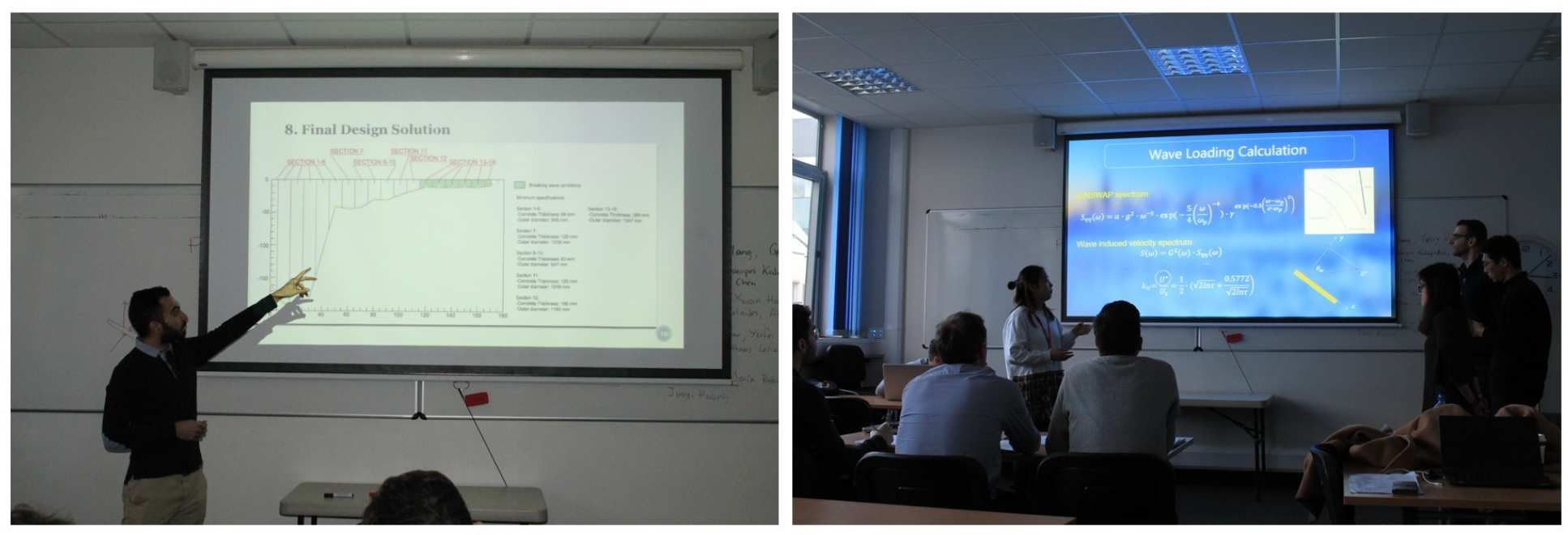
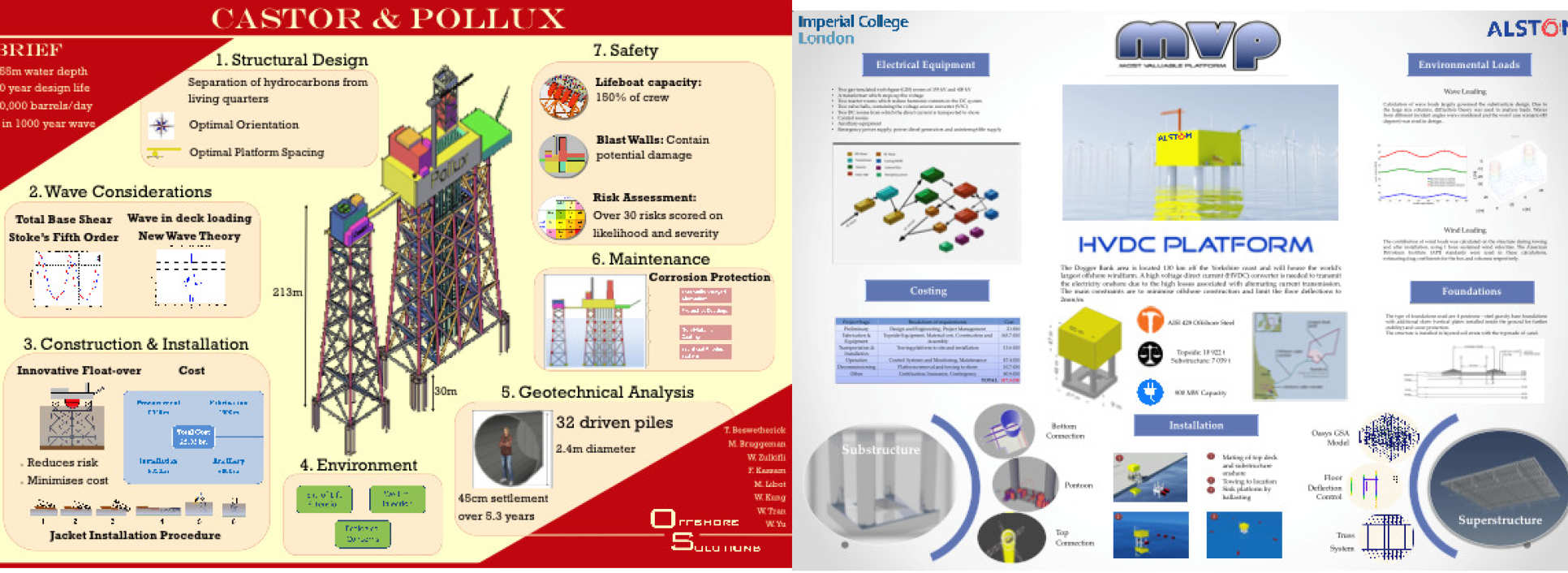
Spring Term modules
CIVE70074 Modelling Tools
Fluid flows are complex (they would be no fun if they were too easy!) but they are everywhere – right from living-and-breathing itself to the environment we experience around us. This module brings together fundamental fluid mechanics with mathematical modeling tools and deploys them to solve genuine physical phenomena of real application.
Core to the module is the distillation of complex physical situations to simplified governing physics and clear communication in both written and oral presentation. The learning that you’ll do in this module will complement and underpin your approaches to solving any fluid flows you’ll meet in this course and in any engineering application – moreover, it will change the way you approach problem solving far beyond fluid mechanics.
Read the full module descriptor.

CIVE70078 Air-Sea Interaction Dynamics
The interaction of the ocean and atmosphere through wind and heat forcing plays an enormous role in driving fluid flows relevant to offshore and coastal engineering design, weather forecasting and climate modelling. Ocean waves are a direct result of momentum and energy transfer from the wind to the ocean and air-sea heat fluxes help drive our weather patterns, provide the fuel for hurricanes and help drive the overturning circulation of the global oceans.
This module draws upon the fluid flow fundamentals associated with turbulent buoyancy-driven flows and wave mechanics and applies that knowledge to the coupled ocean-atmosphere system. During this module we will cover topics related to vertical variability in wind speed over the ocean, spectral wave modelling, energy dissipation by breaking waves, turbulence in the upper ocean and the effect of the Earth’s rotation on ocean currents. The incorporation of a hands-on practical will allow you to collect and analyse a wind-wave interaction dataset in order to apply the theoretical knowledge gained during the formal lecture course.
Read the full module descriptor.
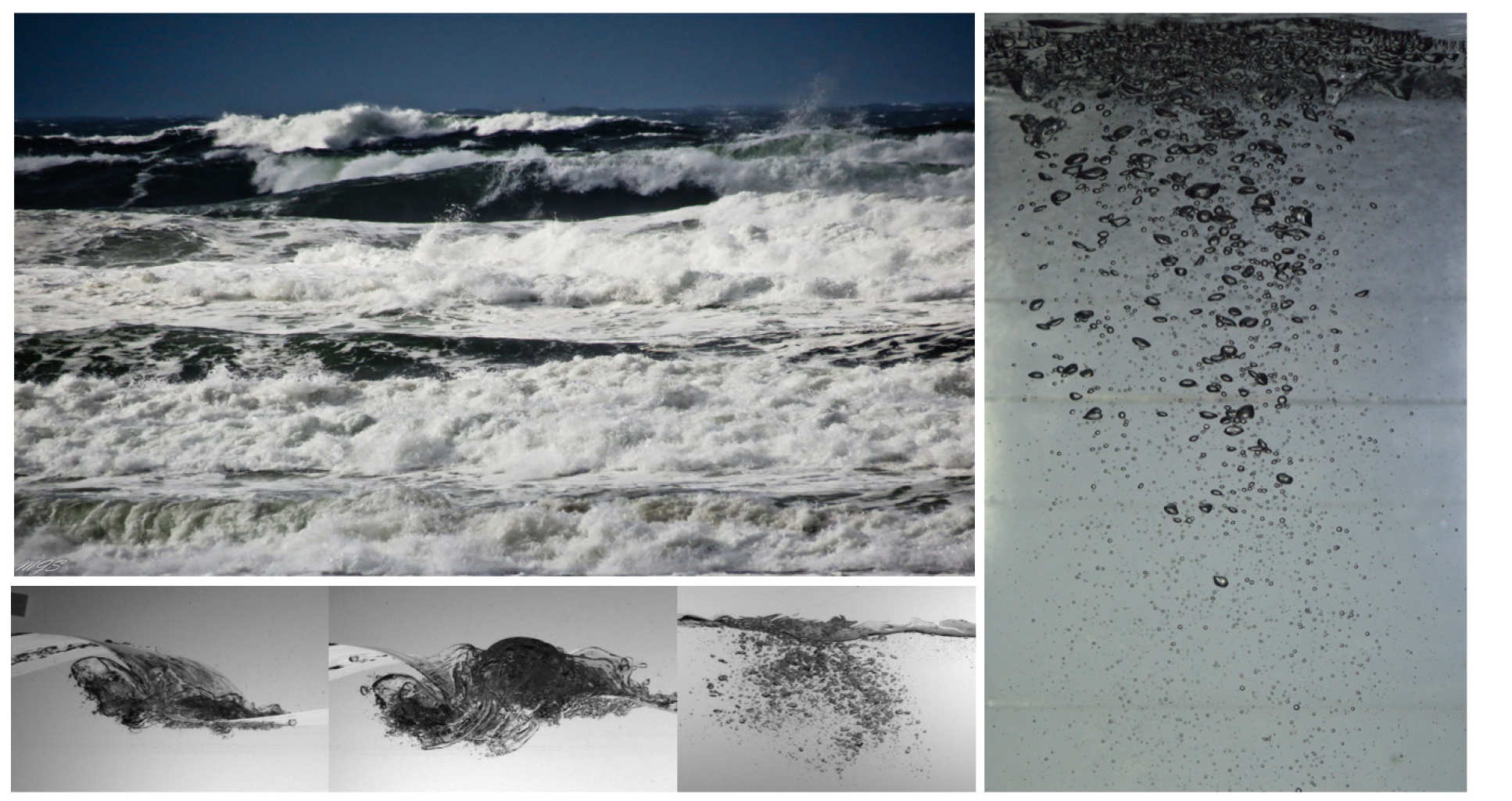
CIVE70079 Computational Analysis
With the advent of high performance computing and sophisticated algorithms, the computational analysis of fluid flow has entered a new era. Direct simulation and the numerical analysis of the equations governing fluid motion yield insights and quantitative information parallels and complements laboratory observations.
This module provides the foundations of a thorough understanding of simulation and analysis techniques that can be employed in engineering design problems. These techniques include the variety of ways in which a system of partial differential equations can be represented in a discrete form by a computer. We will discuss the implications of various approaches to discretisation, including accuracy and stability. The module will discuss numerical methods for free-surface flows, confined and unconfined turbulence and complex geometry.
This is a `hands-on’ module in which practical engineering design problems will be modelled and solved in class using a wide variety of numerical techniques.
Read the full module descriptor.
![[Top] The enstrophy field from the direct numerical simulation of a confined space heated and cooled by isolated sources of buoyancy, [Bottom-left] A two-dimensional simulation of the flow around a cylinder using the discrete vortex method, [Bottom-right] The enstrophy (a measure of rotational energy) from the simulation of a turbulent thermal plume.](/media/migration/faculty-of-engineering/CI9-FM-07_Computational_analysis--tojpeg_1481120791809_x2.jpg)
CIVE70081 Coastal Processes
90% of the World’s trade is exported by sea, and all these vessels need to dock at ports and harbours to offload their cargo. In addition, recent winter storms in the UK wrecked havoc by causing major coastal flooding. As such an appreciation of nearshore processes is necessary for engineers to design ports, harbours and coastal defenses.
This module will teach you the key coastal processes and equip you with the necessary tools. The subject will build on the Wave Mechanics module and complement the material of the Fluid Loading module. You will first be taught about the key wave transformations such as shoaling, refraction, diffraction and wave breaking. This will be followed by the introduction of coastal structures such as sea walls and breakwaters. The module will then present the importance of water level and the influence of tides and storm surge. You will then learn about the processes very close to the shore such as surf-zone hydrodynamics and sediment transport. Finally, you will learn the fundamentals of designing state of art coastal protection techniques.
Read the full module descriptor.
![[Top-left] Gorey harbour, Jersey at low tide, [Top-left] Example of a Coastal Structure: Llandudno Pier, Wales , [Bottom] A recreational beach in the Mediterranean Sea in calm and storm conditions](/media/migration/faculty-of-engineering/CI9-FM-09_Coastal_processes--tojpeg_1481122682233_x2.jpg)
CIVE70082 Energy Systems
With the expanding global population, the demand for energy is increasing whilst simultaneously our traditional, finite energy supplies are reducing. As such, there is a strong push towards sustainable solutions and Fluid Mechanics has a central role to play in generating, harnessing and consuming energy.
This module will provide you with a broad overview of energy systems and the role of thermodynamics in assessing solutions. You will examine energy demand, supply, resources and usage. The specific applications will consider marine renewables (wave, tidal and offshore wind), hydroelectric power and solar energy. You will critically assess these technologies and their key advantages and disadvantages in conjunction with the overall economic and policy setting.
This will allow you to apply the knowledge introduced throughout the MSc course to realistic energy systems. It provides a perfect link to the 4 design projects and industry application that you’ll need once you enter the work force.
Read the full module descriptor.
![[Top-left] Three Gorges Dam, China, [Top-right] Wake from offshore wind turbine array, [Bottom-left] Pelamis wave energy converter, [Bottom-right] Solar power tower, Seville, Spain.](/media/migration/faculty-of-engineering/CI9-FM-10_Energy_systems--tojpeg_1481122949021_x2.jpg)
CIVE70083 Urban Fluid Mechanics
More and more of us are living in cities. Currently, the number stands at 3.97bn and this number is expected to rise to 6.42bn (66% of the world population) in 2050. This will exert significant pressures on the air quality, energy consumption, noise levels, biodiversity and general well-being of the population. These pressures are exacerbated by the expected increase in the frequency of extreme weather events such as storms and droughts that climate change will bring. In order to overcome these challenges, it is crucial to understand and model the flow of air, heat, water vapour, water and pollutants, both outside and inside buildings.
The module is designed to bring you to the forefront of the current knowledge in modelling the built environment. It will cover the exchanges of the city with the atmosphere and the urban heat island effect, air quality, indoor climate and building energy performance. The module will cover strategies to make urban areas both sustainable and resilient to climate change and the challenges that need to be overcome to make these happen.
Read the full module descriptor.
![[Top-left] Urban heat island in Atlanta, USA, [Top-right] Green roof of city hall, Chicago, Illinois, USA, [Bottom] Beijing on a clear and smoggy day](/media/migration/faculty-of-engineering/CI9-FM-11_Urban_fluid_mechanics--tojpeg_1481558405622_x2.jpg)
CIVE70084 Design Projects
This module will prepare you for entering industry by teaching design principles and best practices in Fluid Mechanics. It will consist of 2 design projects that bring together and consolidate all aspects of the taught material. The design brief will be formulated with help from industry members, who will also make up the client panel for judging the projects. You will work in small teams and during these projects you will be taught industry-standard tools/software as required. At the end of each project you will hand in a design report and give a group presentation to the client and your peers. This module emphasizes design principles, team working, writing and presentation skills as well as consideration of health and safety, risks, finance and sustainability.
There will be a project in two of the following areas:
- Offshore Engineering
- Coastal Engineering
- Environmental Flows
- Built Environment
Read the full module descriptor.


Summer term modules
CIVE70085 Research Project - Fluid Mechanics
During this module, you will undertake research with one (or more) of the leading academics within the Fluid Mechanics section. You may also choose to undertake this research project in the form of an industry placement. You will submit a literature review, a dissertation and give a final presentation at the end-of-year student conference. This module will emphasise independent work, literature review, technical writing, oral presentation, time management and forming and defending hypotheses.
Read the full module descriptor.
See the project titles for some of our previous students. 2017/18, 2018/19.
Image sources
- Vortex at the tip of an aeroplane. (Courtesy of NASA Langley Research Center (NASA-LaRC)
- Plug hole vortex. (Courtesy of Robert D Anderson
- Streak lines in camp fire. (Courtesy of Abrget47j
- We will show you how to go from real-world complex flows like the smoke plume picture to simple solutions that describe the dominant physics. (Courtesy of Imperial College London)
- View of the uranium mill tailings pile in Moab, Utah. (Courtesy of Unknown photographer/Department of Energy
- Sediment transport within Toklat river, Alaska, USA. (Courtesy of Dawn Endico
- Coastal sediment transport at Assateague Island, Maryland, USA. (Courtesy of Susanne Bledsoe, U.S. Army Corps of Engineers
- Air pollution from fossil-fuel power station. (Courtesy of Alfred Palmer - Library of Congress, Public domain
- Breaking wave (Courtesy of Unsplash, creative commons license, CCO 1.0
- Breaking wave (Courtesy of NOAA, Public domain mark 1.0
- Rough seas (Courtesy of Mark Smith, creative commons license, CC BY-ND 2.0
- A plunging breaking wave photographed in the Coastal flume within the Hydrodynamics laboratory (Courtesy of Imperial College London)
- Dust storm in Afghanistan (Courtesy of Cpl Daniel Wiepen, Open Government License)
- Horizontal convection produced by the differential heating of a horizontal boundary condition (Courtesy of Imperial College London)
- A horizontal slice through a confined space heated and cooled by isolated sources of buoyancy (Courtesy of Imperial College London)
- Laboratory demonstration of directional wave-wave interactions in the Wave basin (Courtesy of Imperial College London)
- Students measure wave propagation in a teaching wave flume (Courtesy of Imperial College London)
- A warm plume, common in buildings, experimentally mimics the warming of a room (Courtesy of Imperial College London)
- Gravity current experiment (Courtesy of Imperial College London)
- The enstrophy field from the direct numerical simulation of a confined space heated and cooled by isolated sources of buoyancy. (Courtesy of Imperial College London)
- A two-dimensional simulation of the flow around a cylinder using the discrete vortex method. (Courtesy of Yorgos Deskos, Imperial College London)
- The enstrophy (a measure of rotational energy) from the simulation of a turbulent thermal plume. (Courtesy of Imperial College London)
- Flow around a column and associated scour hole. (Courtesy of USGS, Public domain mark 1.0
- Modelling spilling and plunging breaking waves and their underlying particle kinematics. (Courtesy of Imperial College London)
- Sequence of photographs of a breaking wave hitting a deck structure, as modelled in the wave basin within the Hydrodynamics laboratory. (Courtesy of Imperial College London)
- Gorey harbour, Jersey at low tide. (Courtesy of FoxyOrange
- Example of a Coastal Structure: Llandudno Pier, Wales. (Courtesy of Diego Torres, creative commons license, CCO 1.0
- A recreational beach in the Mediterranean Sea in calm and storm conditions. (Courtesy of Jose Alsina, Imperial College London)
- Three Gorges Dam, China. (Courtesy of Le Grand Portage
- Wake from offshore wind turbine array. (Courtesy of Vattenfall, creative commons license, CC BY-ND 2.0)
- Pelamis wave energy converter. (Courtesy of P123
- Solar power tower, Seville, Spain. (Courtesy of afloresm
- Urban heat island in Atlanta, USA. (Courtesy of NASA Earth Observatory, Public domain mark 1.0).
- Green roof of city hall, Chicago, Illinois, USA. (Courtesy of TonyTheTiger
- Beijing on a clear and smoggy day. (Courtesy of Bobak
- Stormy Seas During Hurricane Winds - Rough Seas at Cannon Beach. Courtesy of Mark Smith, creative commons license CC BY-ND 2.0.
- Studying Bubble Plumes in the Laboratory (Image collected at Scripps Institution of Oceanography)
- Studying Bubble Plumes in the Laboratory. (Courtesy of Imperial College London).
Frequently Asked Questions (FAQ's)
What are my options after graduating from the programme?
The world will be your oyster! As the programme is designed to provide you with the essential skills that are applicable across all Fluid Mechanics disciplines, you will have a wide range of options upon graduating. This could involve working in the industry or government sectors or undertaking further research in the shape of a PhD. Whichever you choose, we are confident that this programme will provide you with the potential to lead the field in your respective area.
How is industry involved with the programme?
Industry will play a large role in the programme, including:
- Delivering guest lectures
- Supervising the design projects (contributions have been made by Ramboll, Breathing Buildings, ARUP, Foster + Partners)
- Offering placements as part of the MSc research project
- Providing scholarships/sponsorships
We have also consulted Engineers within industry during the design of the programme itself, such that it helps meet their needs and also equips graduates will all the necessary tools for entering the work force.
What facilities are available?
The programme will be taught in excellent, modern facilities including:
- World-class hydrodynamics laboratory
- Lecture rooms
- Computer laboratories
- Civil Engineering library
- Breakout Student Space (BOSS)
Are there any scholarships opportunities?
Yes, there are Departmental and other scholarships available for the very best students. If you are interested in receiving a scholarship, then early application is strongly recommended.
Visit this webpage for information about scholarships and funding opportunities.
Who are we?
We are an enthusiastic and fun group of academics that are leading experts in Fluid Mechanics. We excel at teaching and research and we are looking forward to teaching the next breed of leading Fluid Mechanics Engineers. Click on the link below for more information about the people within our section.
How is the programme assessed?
Assessments include individual and group courseworks; laboratory and design projects; oral presentations; written examinations and a research dissertation. To complete the requirements of the degree, all assessments must be undertaken to the appropriate level. Successful candidates will be awarded the MSc degree of Imperial College London.
How do I apply?
Information on how to apply and the link to apply can be found here: Application Information
Haven't found an answer to your query / question?
| Photo | Details |
|---|---|
 |
For questions and advice relating to MSc application, basic eligibility, supporting documentation required, and information on entry to our postgraduate taught (MSc) programmes, and general information pre-registration. Postgraduate Taught Office Prospective students and applicants should contact: msc2023@imperial.ac.uk or call Yamini, +44 (0)20 7594 5932. Current students should contact: cvpgo@imperial.ac.uk or call Yamini, +44 (0)20 7594 5932. |
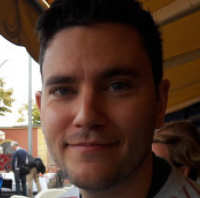 |
For all queries related to the academic content of the programme. Programme Director Dr Adrian Callaghan, +44 (0)20 7594 6644, a.callaghan@imperial.ac.uk |
 |
For all other queries. Programme Administrator Rebecca Naessens, +44 (0)207 594 5990, rebecca.naessens@imperial.ac.uk |
| Administration contacts for the Fluid Mechanics cluster | |
MSc Application Information
Minimum academic entry requirements
- A good Upper Second or First Class Degree result (or International equivalent), in engineering or another numerate discipline, or Masters level degree qualification
- Good mathematical skills (B or above at A-level or equivalent qualification)
- Relevant Postgraduate industrial experience is favoured
- English Language qualification (where relevant)
Please also check that your previous study meets the minimum academic requirements by country index.
Note: The Department may set higher requirements than those specified by the College as minimum entry requirements and that places are not guaranteed for any applicant. Relevance of degrees and eligibility can be checked with the Department.
English Language Requirements
Applicants for whom English is not their first language must demonstrate a minimum level of English language proficiency for admission to the College. This may follow the application if not available at the time of submission. Please see the College English language requirements for postgraduate applicants for information. Please also check that your previous study meets the minimum academic requirements by country index.
Visa requirements for International Students
Please visit the international students website for more information: https://www.imperial.ac.uk/study/international-students/visas-and-immigration/
Apply Now
We hope you have found all of the information you need to reach a decision. If you would like to apply for this programme, please follow the application instructions here: Application Information and application link.
More about the College
More about the Fluid Mechanics Section
Further resources for this programme
Further resources for this programme
| Type | Document |
|---|---|
| Webpage | Handbook |
| Webpage | Programme Specification - Fluid Mechanics Cluster |
| Pdf document | Professional skills development for Master's students |
| Webpage | Imperial College Terms and Conditions |
| Webpage | Entry on the College Prospectus |
| Resources for this programme | |
Our community in numbers*
Our academics
- 50+ full-time academic staff
- 20 part-time, honorary and visiting
- 50+ research staff
- 40+ Professional Services and Technicians staff
Our student population
- 225 PhD students
67% male; 33% female
48 nationalities - 314 MSc students
61% male; 39% female
53 nationalities - 367 Undergraduates
71% male; 29% female
45 nationalities - Total 906 students
67% male; 33% female
* all numbers are approximate
Measures of success
Research Assessment Exercise
- REF 2021. 75% of research assessed to be 4* (highest rating), 25% assessed to be 3*.
QS World Universities rankings
- Subject Ranking. Civil Engineering = 6th (2021); 6th (2020); 6th (2019); 3rd (2018)
The Times Higher Education world ranking
- Subject Ranking. Civil Engineering = 4th (2021); 11th (2020); 12th (2019)
National Student Survey
- Overall Satisfaction, 92% (2022), 90% (2021); 78% (2020); 88% (2019)
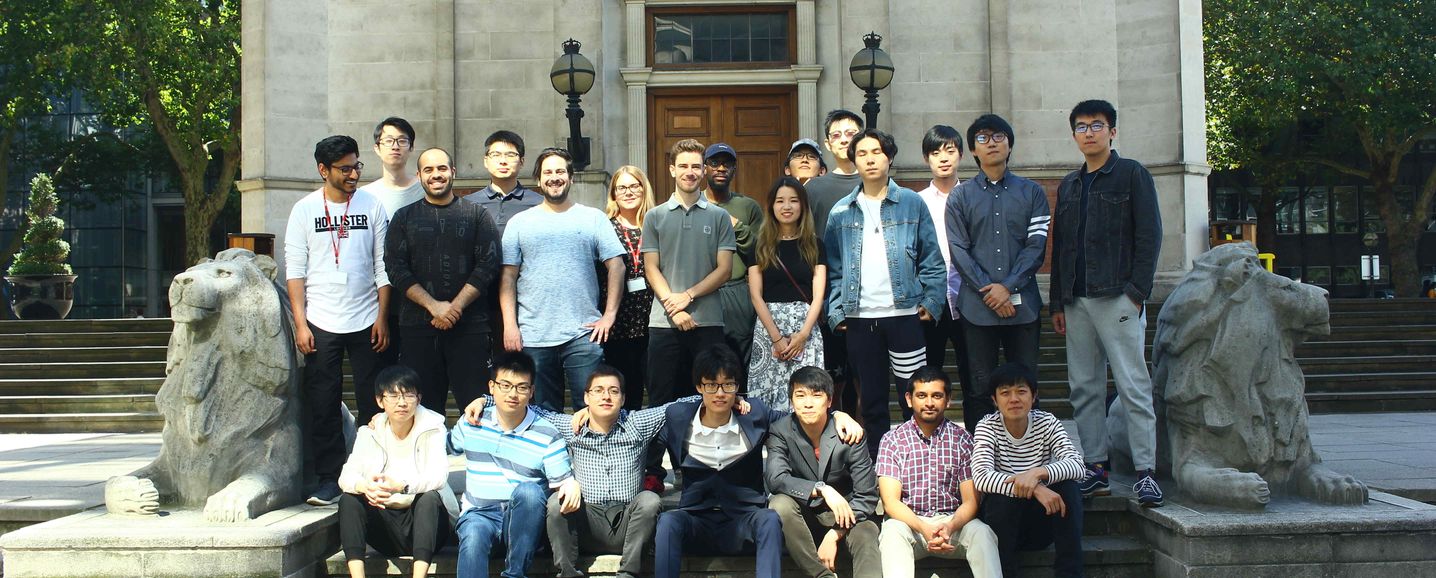
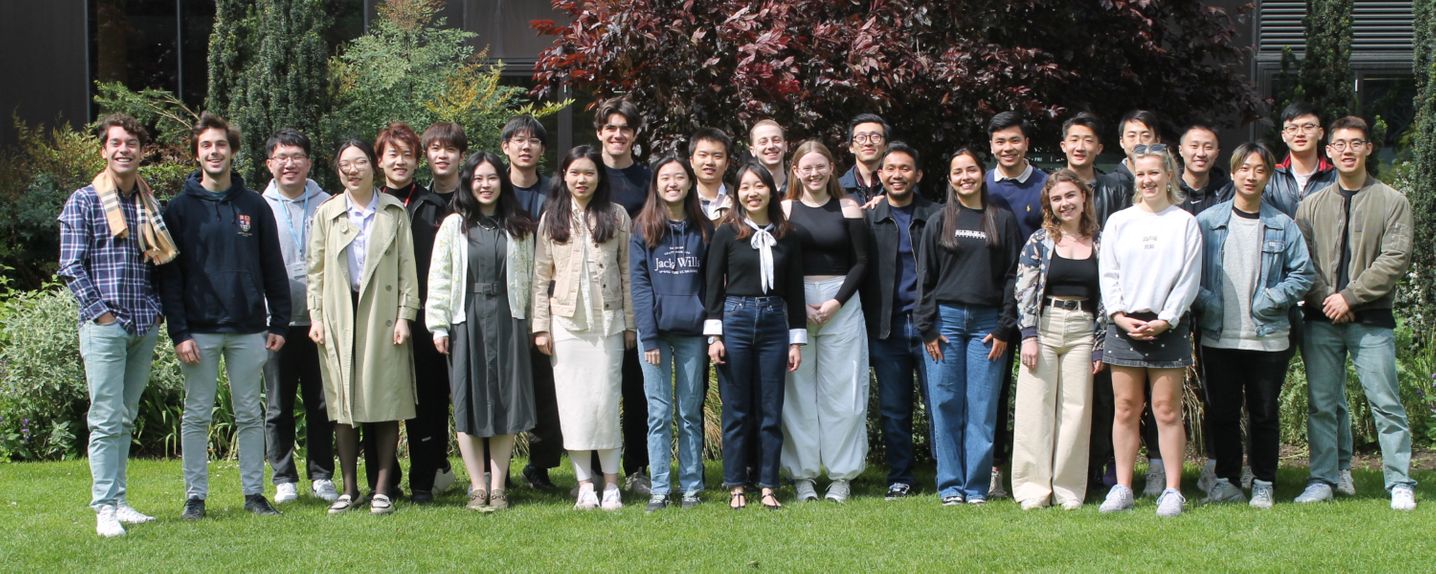
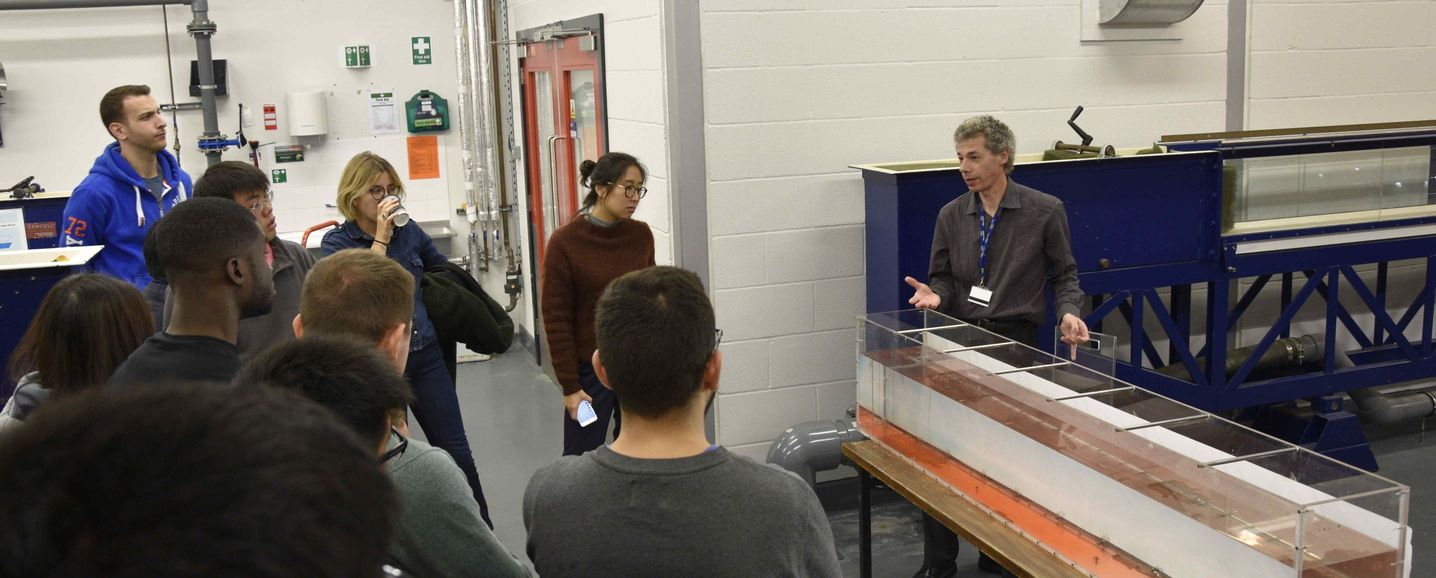
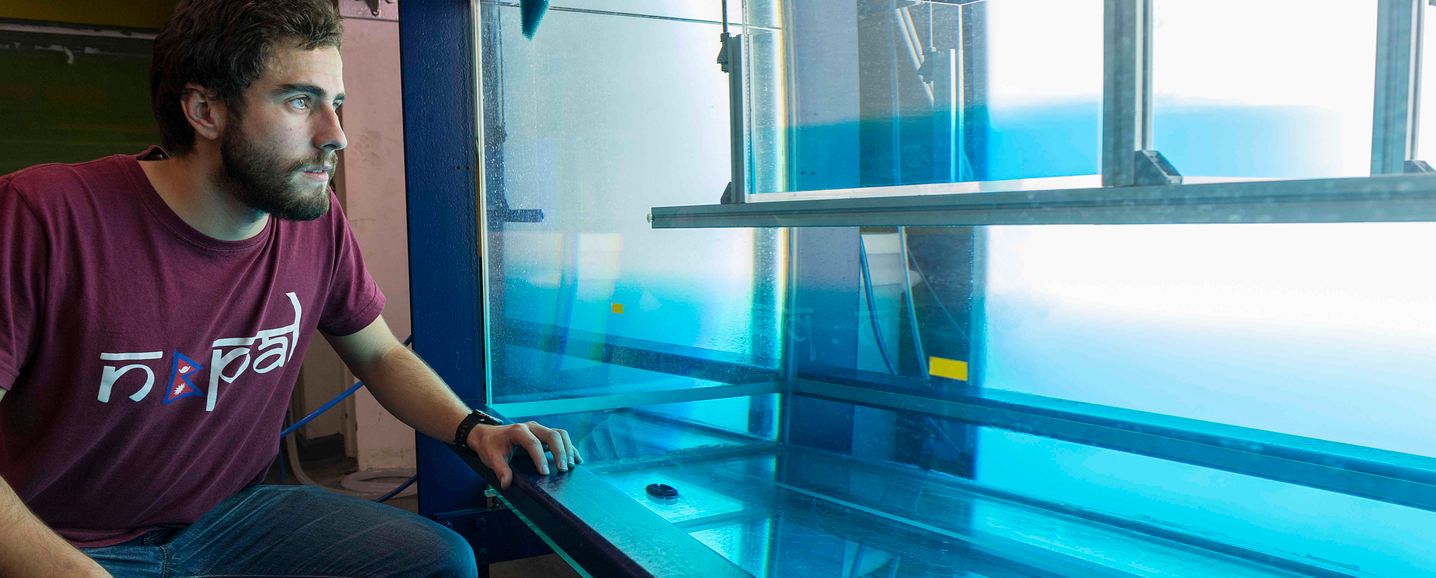
--tojpeg_1583317536739_x4.jpg)
